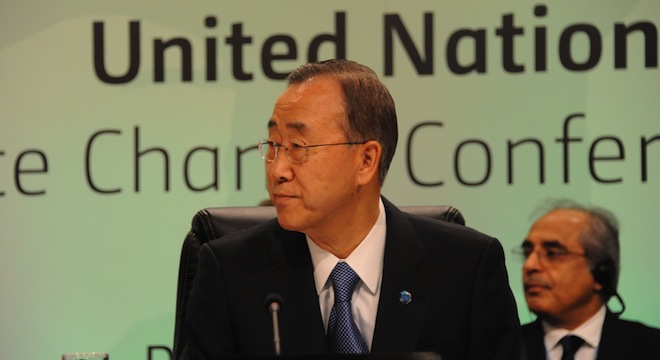EMILY GERTZ
It looks as though the 2011 U.N. climate talks will go down in history as another failed attempt to achieve international agreement on fighting global warming.
That’s at least the feeling of U.N. Secretary General Ban Ki Moon, who on Tuesday addressed the COP17 (Conferences of the Parties 17) summit in Durban, South Africa, saying in a prepared statement: “The ultimate goal for a comprehensive and binding climate change agreement may be beyond our reach — for now.”
That news came as China upended the second week of the UN climate talks with an announcement Monday that the country would agree to legally binding cuts in carbon emissions after 2020, a historic shift.
“China’s comments by China’s chief negotiator signaling a shift away from longstanding resistance to a binding emissions pact sent a charge through Durban’s conference center,” The Wall Street Journal reported (paywall).
At the least, the move marked a dramatic about-face from China’s refusal to sign onto a binding emissions-reduction agreement at the 2009 COP15 UN climate talks in Copenhagen, Denmark.
But chief negotiator Xie Zhenhua also stated Monday that China’s new move comes with an extremely huge caveat: The participation of Western nations, including the U.S., which would need to make very aggressive cuts of their own.
“[S]ome key negotiators wondered whether China was throwing down the gauntlet to shift pressure on to Western countries to address climate change,” according to the Journal.
But U.S. representatives said that China was all-talk.
“It is not my impression that there has been any change at all in the Chinese position in regard to a legally binding agreement,” U.S. envoy Todd Stern told reporters after meeting with the Chinese delegation, USA Today reported.
Meanwhile, Canada, already a multiple award-winner of the negative “Fossil of the Day” title at these talks, officially affirmed reports that it would not sign on for a second phase of commitments to reduce greenhouse gas pollution when the current phase ends in 2012.
Environment Minister Peter Kent stated on Monday that China’s proposal, while “interesting,” didn’t have much in the way of specifics, and that in any case it wouldn’t change Canada’s stance, the CBC reported.
With Japan and Russia also promising to sit out any second round of cuts under the Kyoto Protocol, and the U.S. an eternal holdout, this would seem to be the end of the line for the treaty. The talks, after all, conclude on December 9.
However, UK Energy Secretary Chris Huhne “arrived on Monday saying there was a ‘real chance’ that the stuttering climate talks could be revived” by China’s move, The Guardian reported.
The UK is party to the European Union’s proposal that a new global agreement come into force by 2020, and include binding cuts for all nations instead of only the select group of industrial nations (called “Annex 1” countries in climate treaty lingo) specified under Kyoto.
But India — which finds itself in a similar situation to China, as a developing economic power and major greenhouse gas polluter — has been resisting the E.U.’s proposal.
So far, China’s shifting stance has not moved India to re-consider, The Economic Times reported, despite comments by Indian environment minister Jayanthi Natarajan that she has “come to Durban with an open mind.”
Natarajan has brought to Durban a list of contentious need-to-knows about any new treaty. India is insisting “climate equity,” arguing that because Western have historically emitted the most pollution, India should get more time to improve its economy without any legally binding carbon cuts.
India also wants more detail on how much climate aid and development funding richer countries will supply to poorer, and when; as well as whether developing countries like India can substitute “mitigation” (such as conserving forests as carbon sinks) for emissions cuts.
India also wants to know how future agreements will tackle trade issues and intellectual property rights. Both factor heavily into the transfer of low- and no-carbon energy technologies from industrial to developing nations.
Against this fragile diplomatic backdrop comes more dismal news on the state of the atmosphere: the Global Carbon Project announced Monday that greenhouse gas emissions rose an unprecedented 5.9 percent in 2010.
“Scientists with the group said the increase, a half-billion extra tons of carbon pumped into the air, was almost certainly the largest absolute jump in any year since the Industrial Revolution,” reported The New York Times, “and the largest percentage increase since 2003.”
Coal-fired energy accounted for more than half the jump in carbon pollution, according to the group.
The hike more than compensated for 2009’s 1.4 percent emissions drop due to the global economic meltdown.
“In the United States, emissions dropped by a remarkable 7 percent in the recession year of 2009, but rose by just over 4 percent last year, the new analysis shows,” reported The Times. “This country is the world’s second-largest emitter of greenhouse gases, pumping 1.5 billion tons of carbon into the atmosphere last year.”









